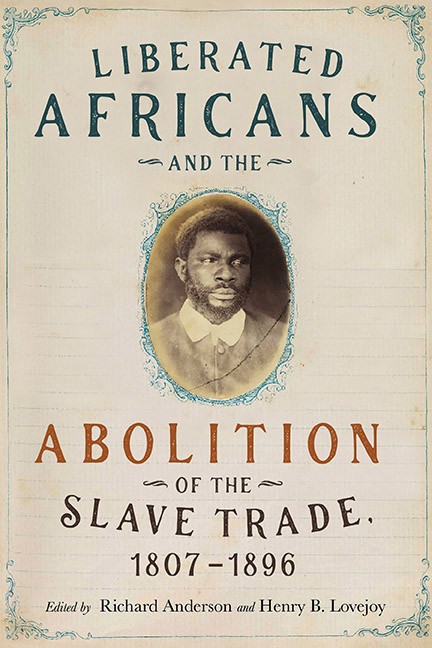Book contents
- Frontmatter
- Dedication
- Contents
- List of Illustrations
- Acknowledgments
- Introduction: “Liberated Africans” and Early International Courts of Humanitarian Effort
- Part One Origins of Liberated Africans
- Part Two Sierra Leone
- Part Three Caribbean
- Part Four Lusophone Atlantic
- Part Five Liberated Africans in Global Perspective
- Part Six Resettlements
- Bibliography
- Notes on Contributors
- Index
3 - Visualizing Abolition: Mapping the Suppression of the African Slave Trade, 1810s–90s
Published online by Cambridge University Press: 21 March 2020
- Frontmatter
- Dedication
- Contents
- List of Illustrations
- Acknowledgments
- Introduction: “Liberated Africans” and Early International Courts of Humanitarian Effort
- Part One Origins of Liberated Africans
- Part Two Sierra Leone
- Part Three Caribbean
- Part Four Lusophone Atlantic
- Part Five Liberated Africans in Global Perspective
- Part Six Resettlements
- Bibliography
- Notes on Contributors
- Index
Summary
“The unwearied, unostentatious, and inglorious crusade of England against slavery may probably be regarded as among the three or four perfectly virtuous acts recorded in the history of nations,” said the great historian W. E. H. Lecky in his 1869 History of European Morals. But what exactly did the British seek to achieve with the abolition of slavery? Through what means? And what were the consequences? These are just three of the questions that have animated the pens of historians of slavery and the transatlantic slave trade. In 1807, shortly after abolishing their own trade, the British engaged in a campaign to suppress the entire traffic. They signed bilateral treaties with foreign nations, deployed a naval squadron to patrol the coasts of Africa and the Americas, and rescued thousands of Africans illegally forced into the Atlantic. The effectiveness of these efforts on the ground was minimal; however, the ideological result was nothing short of monumental. The trade not only ended in less than a century, but the campaign also shifted the world’s attitudes toward slavery: from one that viewed it as morally acceptable to another that considered it inhumane.
Given the nation's prominent role, historians have naturally paid more attention to Britain than to any other country involved in this suppression effort. However, not all of them agree on British intentions and objectives. Some argue that the British were economically interested in the suppression of the trade. Eric Williams, for example, believes that slavery and the slave trade helped finance the Industrial Revolution in England, but, when industrialization reached maturity, “the British West Indian monopoly, prohibiting the importation of non-British-plantation sugar for home consumption, stood in the way.” Other historians view British abolition in a dramatically different way, noting that, by retreating from the traffic, the British were actually committing an economic suicide, since plantation slavery in the West Indies was actually expanding at that time. Seymour Drescher points out, “Economic interests cannot account for either the timing, the occurrence, or the maintenance of the abolition of the slave trade between 1787 and 1820.”
- Type
- Chapter
- Information
- Publisher: Boydell & BrewerPrint publication year: 2020



